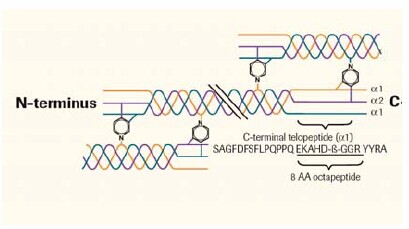Specific antibodies against NTX and CTX make it possible for detecting bone metabolism markers by ELISA Kit

Calprotectin, usually known as S100A8/A9, is a heterodimeric complex composed by two components, S100A8 and Mature collagen molecule has a structure of 3 short non-helix peptide chains at its N-terminal (N terminal) and carboxyl terminal (C terminal). It is called terminal peptide (Telopeptide). Type I collagen cross-linked N-telopeptide (NTX) and type I collagen cross-linked C-terminal peptide (CTX) are widely used as markers for collagen degradation. Both of NTX and CTX can be detected in serum and urine. Wherein the urinary NTX (Cross Linked N-Telopeptide Of Type I Collagen, cE90639Hu) is the direct product of type I collagen degradation by osteoclast. Not only could NTX be used to screen out risk factors for post-menopausal osteoporosis, but also it can monitor the body's response to treatment. CTX epitope contains Alpha (Alpha-Crosslaps (aCTx), CEA898Hu) and Beta (Beta-Crosslaps (bCTx), CEA892Hu) types. Alpha type is originated from degradation of newly formed collagen, whereas Beta type is formed by degradation of mature collagen . In some bone diseases where a rapid bone turnover occurs in newborn bones such as multiple myeloma, bone metastases, and Paget's disease, the level of both types of CTX are increased.
Currently the main method to detect NTX and CTX is electricity chemiluminescence immunoassay (ECLIA). However, the wide application of ECLIA is restricted by some factors, for example, tris(bipyridine)ruthenium marker needed for ECLIA is quite expensive; imported automation equipment and Kits are required; Electrochemiluminescence Detector used for scientific research is rare in the market; and rapid detection for large quantities of samples is impossible. This method is mainly used in clinical testing but unable to meet the requirement of scientific research. NTX and CTX type I collagen are peptides dissociated from terminals during degradation. Their molecular weight are very small. It is difficult to obtain antibodies if they are used to immunize animals directly. According to the properties of the two small peptides, the researchers of Cloud-Clone Corp. have coupled NTX and CTX to the carrier proteins respectively, which helps generate immunogenicity. In this way, monoclonal antibodies with high specificity and sensitivity have been obtained and then ELISA Kit with high specificity has also been developed on this basis.
ELISA Kits for NTX and CTX developed by Cloud-Clone Corp. can be used for measurement of proteins with rapidness, sensitivity and specificity. In addition, no special requirement such as experimental skills of the operator, detection equipment and experiment conditions is needed for this method, which will meet the needs of most scientific researchers.
Many other ELISA Kits related to bone metabolism have also been developed by Cloud-Clone Corp., for example, ELISA Kit for Procollagen I N-Terminal Propeptide (PINP, SEA957Hu), ELISA Kit for Procollagen I C-Terminal Propeptide (PICP, SEA570Hu), ELISA Kit for Alkaline Phosphatase, Liver/Bone/Kidney (ALPL, SEB091Hu), ELISA Kit for Acid Phosphatase 5, Tartrate Resistant (ACP5, SEA902Hu), etc. Please find more detailed information at www.cloud-clone.us.
